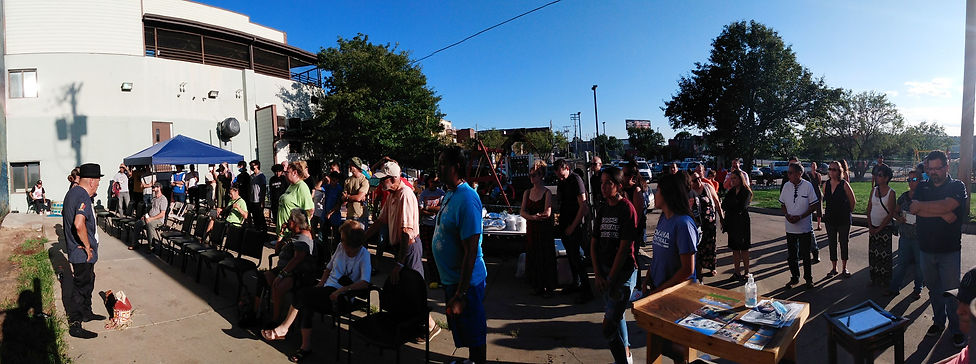
ANCESTRAL VOICES
NATIVE AMERICAN COMMUNITY MURAL

The Artists
In addition to Native American Youth coming to help frequently and many families joining us on community paint day (and several days afterwards) here is our team of artists:
Lead Artist:
Aaron Olivo
Contributing Artists:
Steve Tamayo
Sara Rowe
Supporting Artists:
Richard Harrison
Hugo Zamorano
2402 N St
Omaha, NE 68107
Project Overview
This mural was created in tribute to the strength and importance of the women in the Native American community. They have historically and continue to be the backbones and leaders of their families and communities. We worked with the Nebraska Urban Indian Health Coalition's SOMS (Soaring Over Meth and Suicide) to create this mural.
We know that the story of the indigenous people of Omaha is the most important story we can tell. For Native Americans in our area there are many challenges, and some exciting new opportunities including a new apartment building at 23rd and N, just a block away from this mural, focusing on providing affordable housing for the Omaha metro area natives.
The letters over the top of the mural spell out the 4 tribes headquartered in Nebraska, the Ho-Chunk, the Isanti (or Santee) the Osni Ponca, and the U-Mo'n-Ho'n (or Omaha Tribe.) We believed that painting the original names for the tribes were important as much of the Native American language and cultural traditions have been fading, as a result of horrible practices by mostly European people forcibly occupying their land. For example, today there are only 70 speakers of Omaha, only 12 of them fluent, and a handful of semi-fluent speakers of Ponca. The University of Nebraska offers classes in the Omaha language, and its Omaha Language Curriculum Development Project (OLCDP) provides Internet-based materials for learning the language. We chose to paint the words in the style of contemporary urban street art to symbolize that the community is alive and changing and being carried into the future by creative, and resilient young people.
The community chose to depict 4 allegorical images of ladies in traditional tribal dress. This is in tribute to the strength of the women in the Native American community, and the leadership they are known for. The faces are without features in the style of Native American dolls and Ledger Art. We wanted to evoke these art forms and for viewers to use their imaginations, maybe even picture their own grandmothers. The artists viewed historical and contemporary images of traditional tribal patterns relating to the different tribes. The images depicted are synthesized from various patterns. Since many patterns are unique to family groups an effort was made to not copy any design too closely, so that the images could relate equally to the whole tribe. The artists were allowed a private showing of many antique Native American garments in the collection of the Joslyn Art Museum.
The night sky depicts the Milky Way and the Big Dipper, both of which were important to the Nebraska Native people. The big dipper is depicted upside referring to the legend that in the spring it spills blessings, causing rain and growth. The earth, including the sacred plants chosen at the bottom of the wall and the 4 rivers that shape the territory of the Omaha Tribe are also sacred symbols. Youth, working with the organization Soaring Over Meth and Suicide, researched plants sacred to local tribes and painted them on the wall.

The community meetings brought up the relationship between Native American and American Bison frequently and we chose to depict them in a way that was evocative of the work of the Nebraska Native Donel Keeler, who's son gave us permission to use his image. Donel was a well recognized Isanti painter who lived in Omaha, and we wanted to pay tribute to his contributions to Native American Art. You can read more about Mr. Keeler here and you can purchase these bison license plates here, which gives a 75% of the cost of the plate towards scholarships for Native American youth. Bison are also at the heart of many sacred legends and symbols to the tribes of this area. Youth mixed the colors for the bison and the patterns were chosen from the 4 tribes as well.
Youth also designed and painted the plants at the bottom. They researched plants that have significance to native people of Nebraska. They chose Blue Buffalo: Purple Coneflower (used medicinally), Milkweed (used as an edible), Prairie Wild Rose (different parts used as an edible, drinkable, or medicinal); Green Buffalo: Chokecherry (edible and drinkable berries); Yellow Buffalo: Prairie Turnip (edible root), Wild Mint(drinkable, medicinal); Purple Buffalo: Prairie Wild Rose (see above), and White Sagewort, more commonly just called Sage/White Sage (which is medicinal.) You can read about these plants and see examples of each in this booklet that was published by UNMC in collaboration with local tribal experts.
We wanted to note that the Mayan Community were involved in making sure we painted this mural and enjoyed participating in painting it. The Mayans of South Omaha have a strong relationship with local Native American people, especially the Omaha Tribe.




Our Completion Celebration was complete with Native American musicians, fry bread, cornmeal cookies and soup!




